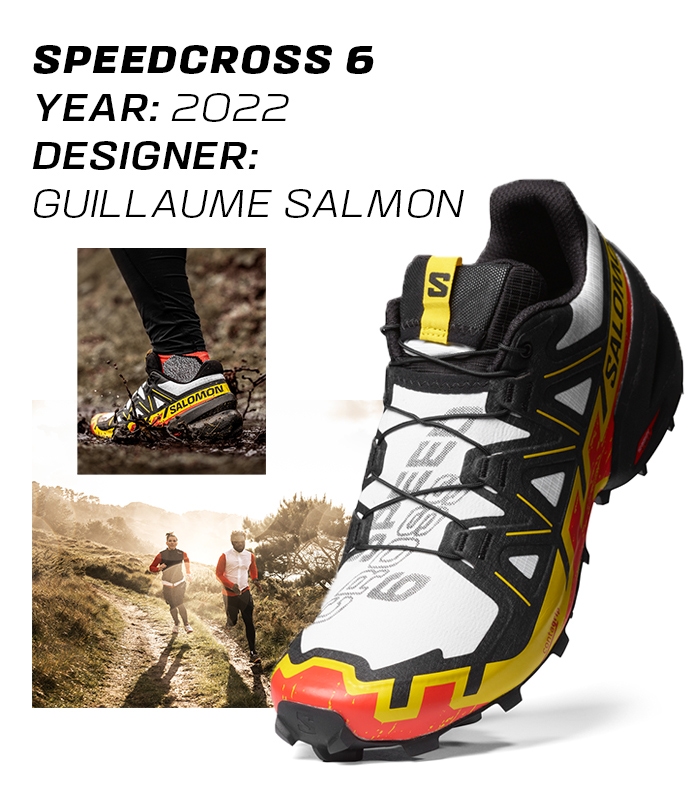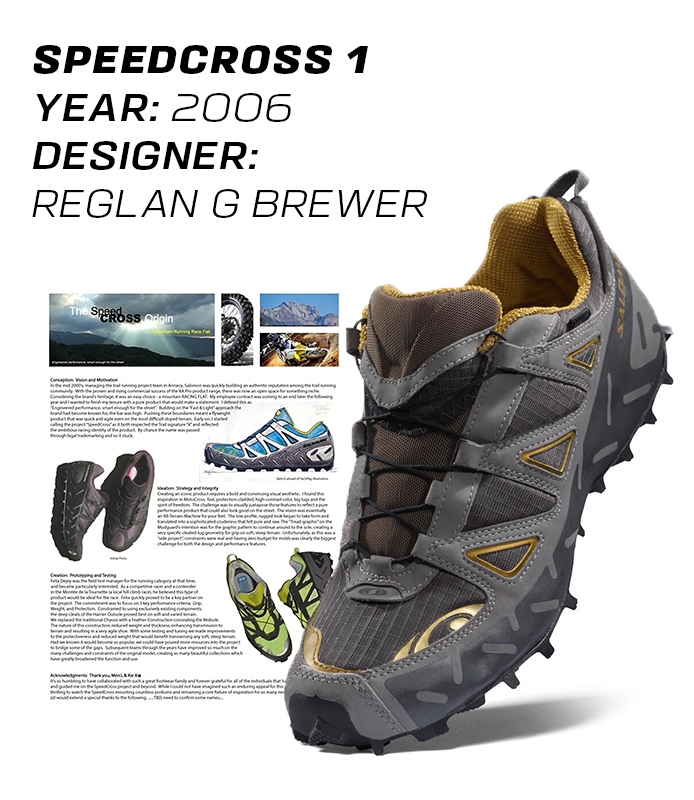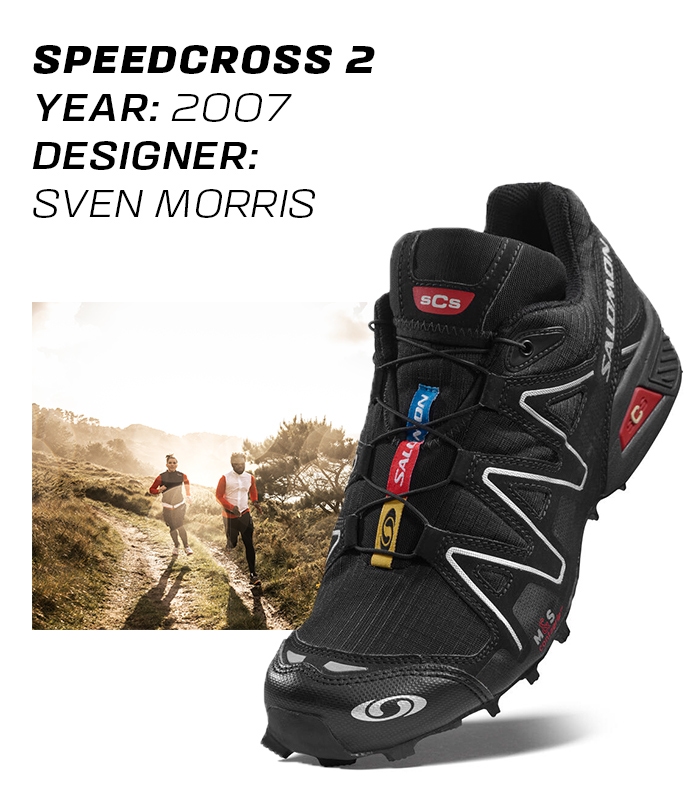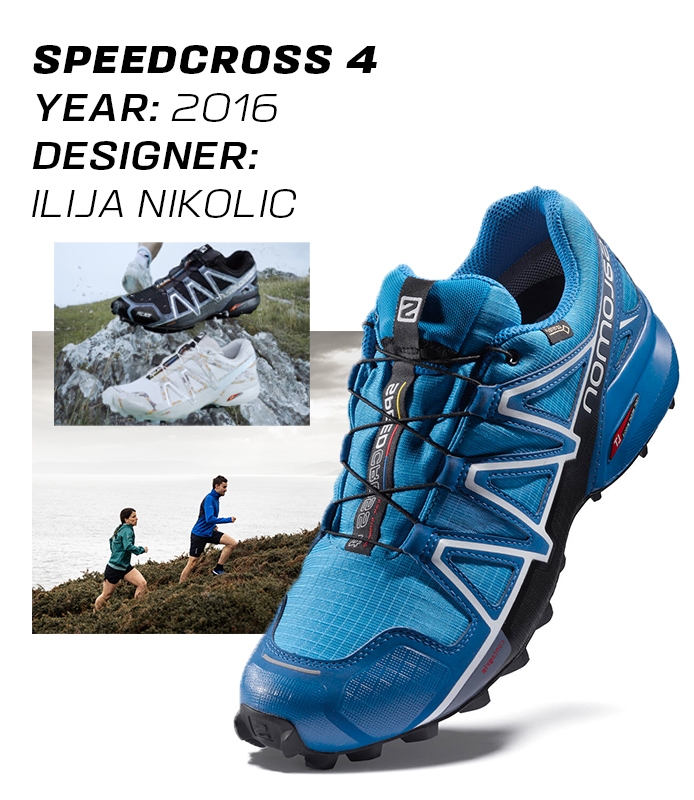

Sixteen years after the release of the first Speedcross, Salomon presents the Speedcross 6, which remains loyal to the source code of the original model as a grippy, lightweight and protective trail shoe. It also harkens back to the original bold design of the Speedcross 1. It remains true to the legendary roots of the Speedcross family, but with a lighter design (298g) and more powerful, grippy connection to the ground in wet conditions. That enhanced grip is due to an updated outsole with Y-shaped lugs that evacuate mud faster. The shoe also delivers that classic Speedcross comfort thanks to a revamped, foot-hugging upper that’s both functional and fiery. Sensifit construction delivers a precise foothold, and the EnergyCell+ midsole compound offers cushioning under the foot.
The design of the shoe recalls the tire-like look that inspired Reglan G Brewer when he designed the very first Speedcross. Guillaume Salmon, who designed the new Speedcross 6, wanted to retain the modern feel of the Speedcross 5, so the shoe’s design works as well in all-black as it does in more eye-catching colorways.
This sixth iteration of the Speedcross was made by a different designer than the person who designed the fifth Speedcross, who was also different from the person who designed the fourth, and so on. Despite each version having a different designer, the Speedcross has remained true to its original source code, its DNA.
Let’s take a trip back in time,
to when “trail running” was known as “mountain racing”.
In the early 2000s, Salomon developed new footwear to meet the need for increasingly fast and light footwear, compared to the usual sturdy hiking shoe like the Salomon Adventure 7, launched in 1994. Inspired by local races taking place near Salomon’s headquarters in Annecy in the French Alps—and by employees, designers and athletes—Salomon footwear designer Reglan G Brewer hatched an idea for a shoe that would be lightweight, grippy, and protective. It represented Raglan’s last chance to create an interesting shoe before his contract with Salomon ended.
The shoe he created would launch a revolution at Salomon, change the rules of mountain running, and contribute to the birth and growth of trail running. It was called Speedcross, and it was made for running fast in the mountains while protecting your feet from rocks and obstacles and delivering stability on wet rocks and in mud. The Speedcross was such a revolution that it would be updated in 2007 and 2011, then twice more: in 2016 and 2019. Let's take a look at the past versions of the Speedcross, to understand where it is coming from.
Pushing mountain racing boundaries meant a flyweight product that was quick and agile, even on the most difficult sloped terrain.

Reglan G Brewer
Salomon Footwear Designer


SPEEDCROSS 1: From Mountain Racing to Trail Running
In the mid-2000s, Salomon was quickly building its reputation in the trail running community. The XA Pro, made for adventure racing, was quite successful commercially, proving that there was a spot for a more niche project. Reglan G Brewer was a designer for Salomon Footwear, who witnessed his fellow Salomon colleagues running in the mountains around Annecy and participating in mountain races such as the classic Montée de la Tournette, a race that climbs 2,000 vertical meters (6,500 feet) to one of the most iconic peaks around the Lake Annecy. Building on the “Fast & Light” approach the brand had become known for, Reglan had a vision.
“Pushing mountain racing boundaries meant a flyweight product that was quick and agile, even on the most difficult sloped terrain,” Reglan explains. “Early on, I started calling the project ‘SpeedCross’ as it both respected the trail signature ‘X’ and reflected the ambitious racing identity of the product.”
The Speedcross was not born from extensive market research or focus groups, but rather an internal attempt at creating buzz. Finding inspiration in motocross tires, the Speedcross began to take shape, with a low-profile and a rugged look that had a “sophisticated crudeness.” The “thread graphic” on the mudguard gave the impression that the shoe could bite the ground regardless of the conditions or the path’s angle of incline. Due to budget restrictions, the shoe could only be developed using existing components. The outsole was borrowed from the deep-lugged XA Harrier. The traditional chassis was replaced by a feather construction that concealed the midsole. People would certainly question the stability of a chassis-less shoe, but this construction provided the agility needed to run faster in the mountains and created a better transition with the ground.
When it came to testing the shoe, Reglan worked with Félix Dejey, who was a competitive racer and contender in the Montée de la Tournette, and who worked with Salomon’s team of trail running athletes. The Speedcross was tested during Advanced Week, where the Salomon trail running team still gathers each year to test products and train together. The athletes, notably the British runners who were avid fell-runners (running and racing in the upland country of northern Britain), were fans of the shoe for its grip, comfort, and look. The Speedcross started to spark excitement.
SPEEDCROSS 2: Finding the Salomon Footwear DNA
The Speedcross 2 was developed off the back of the original. The goal was to keep the essence of the Speedcross 1 while making it more accessible and more recognizable as a Salomon shoe.
The Speedcross was the seed to capture the trail running market.

Sven Morris
Salomon Footwear Designer


The end of the 2000s was a pivotal period for Salomon, as the company was gaining traction in hiking and mountain racing. The team internally wanted to take adventure racing to the next level, and the Speedcross was the obvious choice to do so. “It was the seed to capture the trail running market,” says Sven Morris, who was a footwear designer for Salomon and worked on the second edition of the Speedcross.
Designers were also looking to discover the Salomon DNA: what is common to all Salomon shoes, and how could they showcase that on the products? The answer was found in the technology: the SensiFit cage holding the foot with its unique zigzag design, and the PowerBand piece that wrapped all around the heel.
“Salomon had always put the hardware first when designing products, the design helped to highlight the technology,” explains Morris. “If a shoe didn’t have the PowerBand and SensiFit, then it wasn’t a Salomon shoe!”
The result was a beefier, chunkier, more aggressive shoe, which could easily be recognized as a Salomon shoe thanks to its unique design elements. When it came time to test the Speedcross 2, the design team would learn a valuable lesson. While the shoe was still appreciated, some athletes complained about a lack of stability under the heel, due to the chassis being removed. This would be addressed in the next generation of Speedcross and eventually lead to the commercial success of the Speedcross.
SPEEDCROSS 3: Stability & Mainstream Success
The next generation of Speedcross came in 2011. Warren Bosomworth, who was a footwear designer for Salomon trail running from 2007 to 2012, delivered the first prototype of the Speedcross 3 in 2010. The positive feedback from Salomon fell running and trail running athletes led to a proper brief for a third Speedcross, which had an updated, wider heel for stability, a seamless welded upper (aligned with other Salomon products at that time), a more cushioned EVA in the midsole, and deeper grooves on the outsole that would deform on impact. The aesthetic of the shoe remained untouched, with the same SensiFit cage and PowerBand warping the heel being highly visible on the Speedcross 3.
What I like the most about the Speedcross 3 is that it carried the original Salomon design aesthetic and DNA, and still does to this day!

Warren Bosomworth
Salomon Footwear Designer


“The (original) Speedcross was a very underground product, which appealed to elite athletes and designers for being raw, without any whimsical design,” explains Bosomworth. “It was pure performance. It was a tough shoe to sell. Being lightweight, grippy and protective was not enough.”
The Speedcross 3 was still a performance shoe, and Salomon trail runners were very fond of it. After trying his first Speedcross in 2007, Scottish mountain runner Tom Owens ran all of his trail races from 2008 to 2011 with the Speedcross 2 and 3. He won the Transalpine Run in 2009 and 2010, the Syraid World Championships of Italy in 2010, and the Sentiero delle Gringe Skyrace Final in 2011. “It was so different to the typical shoes available in the UK,” Owens recalls of the early Speedcross models. “ It was super comfortable for trail sections yet had good grip. Essentially it could be used on all terrains and be comfortable for the feet!”
Philipp Reiter is a trail runner from Germany who has been working with Salomon for over a decade. He was also part of the team of runners who tested the Speedcross in the 2000s. “I’m a big fan of colors, and the Speedcross has some really nice colors,” Reiter says. “It’s very comfortable with a brilliant grip. I ran every Speedcross from the second to the fifth, my favorite being the third, but I’ve always loved how dynamic this shoe is.”
The Speedcross 3 solved the stability issues from earlier versions and confirmed that this unique design had amazing potential, not just in the trail running world. By 2015, Salomon had sold more than 20 million pairs of Speedcross.
“What I like the most about that shoe is that it carried the original Salomon design aesthetic and DNA, and still does to this day.” says Bosomworth.
SPEEDCROSS 4: The Visual Update
The Speedcross 4 might not be the shoe that history will remember, but it was a step that was needed to better understand the source code of the shoe. Ilija Nikolic, another Salomon designer who worked on updating this shoe, was afraid of “breaking” the icon that the Speedcross 3 had become.
It is tough to work on a shoe that is already this popular. You want to improve it, but you are scared that by doing so, you will lose what made it popular in the first place.

Ilija Nikolić
Salomon Footwear Designer


“It is tough to work on a shoe that is already this popular,” Nikolic says. “You want to improve it, but you are scared that doing so, you will lose what made it popular in the first place.”
Still, there were a few aspects that had to be corrected, including issues with the crampons and the collar which would become worn quite quickly. The Speedcross 4 tried to lower the shoe and change the lugs to make it more accessible. While the Speedcross 4 did well commercially, outselling the hugely popular Speedcross 3, this update took away what made the Speedcross successful: its aggressive silhouette with chunky lugs.
The feedback from Parisian store The Broken Arm and German designer Boris Bidjan Saberi, who had both worked with Salomon on footwear collaborations, was that this Speedcross 4 took away the uniqueness of the previous versions, trying to make it fit in the “trail running mold”. While it was still successful, designers felt the need to return to the source code of the Speedcross.
SPEEDCROSS 5: Re-Designing a Legend
To design the Speedcross 5, Salomon designer Baptiste Tarenne wanted to find the original DNA of the shoe, in order to stay true to what made it an icon.
“The source code is the fundamental origin of the shoe; the essence,” Philippe Besnard explains. “Its definition is unique. The shoe can evolve from there, but the essence will never change. With Speedcross, you know it’s ready for outdoor unpredictability just by looking at its athletic silhouette and aggressive lugs. You can see that it will be agile and bite the ground because of the lugs. It’s like a motocross tire, with no compromise.”
We needed the Speedcross to be more Speedcross!

Philippe Besnard
Salomon Footwear Designer


The challenge for the Speedcross 5 was to magnify the shoe in a new and modern way. “We needed the Speedcross to be more Speedcross,” Besnard says bluntly.
The Speedcross 5 has a higher profile, more lugs on the outsole, improved comfort and fit around the foot, returning to everything that has made the Speedcross an icon over the years. Speedcross 5 was built to deliver more comfort and more grip, with bigger lugs and a bigger bottom unit.
The shoe had also become a hit with urban consumers and even designers from the fashion world. The colors for the Speedcross 5 were not just designed for a core sports audience. In short, the shoe was made to be wearable beyond the world of trail running.
“We designed the Speedcross 5 so it could work as well with a triple-black color as with a more colorful outfit,” explains Benjamin Grenet, Salomon Footwear Designer. “There are two kinds of excitement as a designer. There is working with a blank slate or working to regenerate and make something more exciting—like the fifth generation of a shoe that we sell millions of pairs of when no one knows how we can make it better.”
SPEEDCROSS: From The Trails To The Streets
Over the years, the unique look of the Speedcross has become popular well beyond designers and trail runners. When Parisian fashion retailer The Broken Arm contacted Salomon to sell the Snowcross shoe—a derivative of the Speedcross that is made for running in the snow, with a high gaiter and a fully waterproof construction—in 2015, it became clear that the Speedcross had a great potential to be worn in the city.
The Speedcross 3’s iconic silhouette that Warren Bosomworth worked on back in 2010 has since been reworked a number of times with new color palettes and gradients. This raw, unique look allows designers to play with each element, add details and appropriate the shoe to give it a different appeal.
You can tell at first sight that it’s a shoe made for trail running: it is not made for anything else than being outdoors, which is why it stands out so well compared to other shoes and brands that are trying to follow a trend.

Guillaume Steinmetz
Co-Founder at The Broken Arm


“The Speedcross has such a radical design, such a raw emotion. You can tell at first sight that it’s a shoe made for trail running, you can tell it’s trail-ready,” says Guillaume Steinmetz, co-founder of The Broken Arm. “It is not made for anything else than being outdoors, which is why it stands out so well compared to other shoes and brands who are trying to follow a trend. With the Speedcross, the source code is so strong that the shoe can be recognized at first glance.”
When asked about the transition from the trails to the streets, Bosomworth agrees with Guillaume. “It’s so unique in its aesthetic,” he says. “It’s raw. It’s not designed to try and appeal to anyone outside of trail running. The more mainstream you try to make it, the less appealing it becomes.”
The Speedcross 4 has also been reworked in collaboration with the likes of Palace, a skateboard brand from London.
Year after year, designer after designer, the Speedcross stayed true to its original intention: running fast in the mountains. While the use of the shoe has diverted as time passed—from hiking trails to parks and runways—the Speedcross remains an icon, and the new Speedcross 6 stays true to the DNA of its predecessors.












